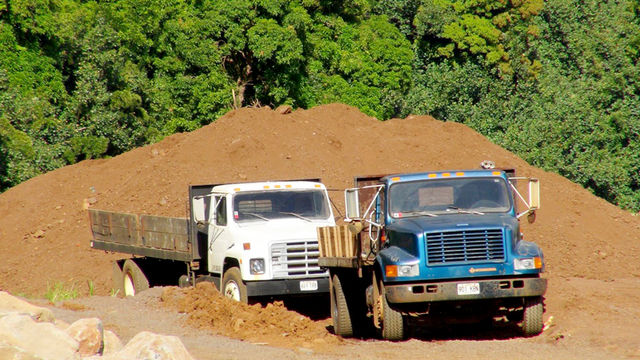LIHUE — In 1995, the Hanalei River bank broke down in a bad way. More than 30,000 tons of eroded soil and sediment have fallen into Hanalei Bay since it jumped its banks, according to the Department of Land and
LIHUE — In 1995, the Hanalei River bank broke down in a bad way.
More than 30,000 tons of eroded soil and sediment have fallen into Hanalei Bay since it jumped its banks, according to the Department of Land and Natural Resources.
Now a riverbank stabilization project is underway with the goal of returning the river back to its original form by restoring the 100-foot section of eroded stream bank located on state land above the Hanalei Wildlife Refuge.
The project is being managed by the Department of Land and Natural Resources.
Over the years, the breach has caused numerous problems in the area, according to DLNR, including environmental pollution, loss of property, stream and reef degradation, and loss of water for nearby taro fields and the refuge.
If left untreated, DLNR says the river would continue to carve a new channel across private and state-owned properties, and ultimately leave 1,000 feet of the Hanalei River dry.
Over the years, flood flows have repeatedly broken through emergency repairs, with the breach channel expanding after every major flood, according to DLNR.
For years, Hanalei biologist and videographer Terry Lilley, who is interested in the river as a nearby resident, has claimed that the mud flowing from the river was causing coral reef die-offs in the bay.
Last week, Lilley grew particularly concerned about the project and alerted residents and public officials in a series of emails about a soil stockpile situated along the river about 100 yards from the Hanalei Bridge. Lilley’s concerns about the soil pile included the legality of its location, the potential environmental effects of rain washing the soil into the river and out into the bay and whether the soil had been tested for heavy metal and other toxins.
“The pile has absolutely no plastic cover or liner to keep it from discharging into the river and sea,” he wrote. “The pile is in the flood plane and wetland that is habitat to 5 endangered birds!”
Lilley also posted his concerns on Facebook.
Last week, the state Department of Health’s Clean Water Branch, through which DLNR has permits for the project, started investigating the soil stockpile that is the subject of Lilley’s concerns. The DOH has been monitoring the project for several months, along with the Army Corps of Engineers, according to DOH officials.
The DOH inquiry into the soil stockpile revealed that some sediment control best management practices were in place. DLNR has been using a silt fencing and filter socks along the perimeter of the stockpile where stormwater could potentially discharge soil into the river.
The DOH plans to recommend that DLNR also use impervious sheeting on top of the soil to further prevent runoff into the river, DOH officials said.
The sediment does not appear to be located in a wetland or otherwise concerning area, according to the DOH.
DLNR Spokeswoman Deborah Ward said the department could not respond to a request for comment on Lilley’s concerns by deadline Monday night.
Matt Heahlke of Goodfellow Brothers, Inc., the project’s general contractor, referred comment to DLNR.
As for the soil’s content, Makaala Kaaumoana of the Hanalei Watershed Hui said the soil is from a certified clean quarry and is not located in a floodplain.
The Hanalei Watershed Hui is not directly involved with the project, but Kaaumoana said the group has watched it closely and participated in public meetings, particularly those involving the environmental permitting process.
“It’s not in the floodplain, it’s clean and it’s extensively permitted,” she said.


